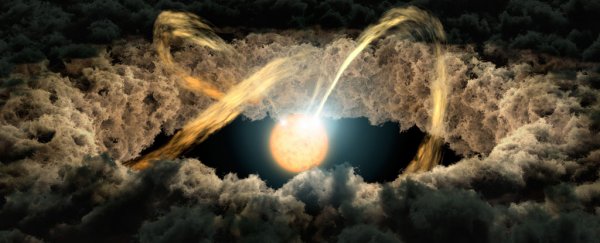When stars are young, they're usually surrounded by a cloud of cosmic gas and dust left over from when it formed. This dense ring, called a protoplanetary disk, is actually where planets themselves are born, as all that matter slowly combines together into spherical worlds over millions of years.
But how big a physical scale are we talking here? Well, we've now got a better idea than ever, with astronomers figuring out how to measure the distance between a star and its surrounding protoplanetary disk for the first time, using a method called 'light echoes'.
"Understanding protoplanetary disks can help us understand some of the mysteries about exoplanets, the planets in solar systems outside our own," said astronomer Huan Meng from the University of Arizona. "We want to know how planets form and why we find large planets called 'hot Jupiters' close to their stars."
So how did they do it? After all, the star in question – a 'baby' star called YLW 16B, at only about 1 million years old – isn't exactly nearby. At a distance of 400 light-years from Earth, YLW 16B is a long, long way away, and has about the same mass as the Sun, despite being much younger (the Sun is approximately 4.6 billion years old).
To gauge the distance between YLW 16B and the stardust around it, the team used data from NASA's Spitzer Space Telescope and four ground-based telescopes in Arizona, Chile, and Mexico.
Using a technique called photo-reverberation (aka light echoes) to measure the travel time of light, the researchers performed a comparison: measuring the difference between the amount of time it took for light to travel from YLW 16B directly to Earth, versus the time it took for light from YLW 16B to bounce off the inner edge of protoplanetary disk and then get here.
Since the speed of light is itself a constant, that short gap in time – about 74 seconds – let them calculate the distance between the star and its surroundings. It turns out that YLW 16B is approximately 0.08 astronomical units from its protoplanetary disk, which is around 8 percent of the distance between Earth and the Sun (which equals about 12 million kilometres or 7.5 million miles, if that helps).
For the method to work, the astronomers needed to find a star with variable emission, with brightness noticeably changing at different times, unlike the steady and therefore less-traceable glow of our Sun. Young stars often demonstrate this unevenness, and YLW 16B turned out to be a suitable candidate.
YLW 16B's own particular stats aren't of particular importance to the team, but the star turned out to be a great test case for this new way of measuring star-to-disk distances, and one which the team thinks could prove more reliable than the previous astronomical method, called interferometry.
"Knowing the exact position of the inner boundary of a protoplanetary disk is important to anyone who wants to understand planet evolution," says Meng.
The findings will be published in the Astrophysical Journal.
